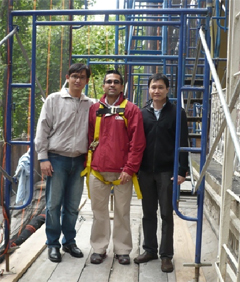
Victor (left) and Jeremy (right) visit with Rand Engineer Vivek Patel, PE during an exterior repair project.
As a structural engineer working for Singapore's Building and Construction Authority (BCA), a government agency that oversees building safety, I recently visited New York with a colleague, Jeremy Tan, to learn about the city's Facade Inspection & Safety Program, otherwise known as Local Law 11/98. Jeremy and I also wanted to get practical experience inspecting buildings with curtain walls and brick-cladding, plastered walls, stucco, and other types of construction.
We had the opportunity to visit Rand and several other engineering firms and observe their engineers and architects as they conducted facade inspections and administered exterior repair projects. We also spent time at the New York City Department of Buildings discussing Local Law 11/98 regulations with DOB administrators.
During our visit with Rand, we met with Vivek Patel, PE, an engineer on Rand's facade and waterproofing team, who took us to several buildings in Manhattan and Brooklyn undergoing Local Law 11/98 repairs. As we walked up the pipe scaffolding, Vivek pointed out building conditions that needed repair, such as spalling bricks and cracked terra cotta, and explained how they were being addressed in the repair program. We also reviewed technical drawings, took quantifications, identified new work items, and observed the contractor make repairs, so it was a terrific hands-on experience.
Singapore has a law similar to Local Law 11/98. Section 28 of Singapore's Building Control Act requires buildings to be inspected by a structural engineer and the engineer to report defects and deterioration that could cause the building to be structurally unsafe. Residential buildings must be inspected every 10 years, and all other types of buildings, including commercial, industrial, and institutional ones, every five years. There is no minimum height requirement as there is with Local Law 11/98, which applies only to buildings taller than six stories.
Property owners in Singapore are required to have their buildings inspected not only when the Building and Construction Authority notifies them, but also whenever defects or deterioration appear, even if it's before the five- or 10-year timeframe for inspections. Owners must then engage a structural engineer to prepare a repair program.
The main difference between New York's and Singapore's inspection laws is the building elements that are inspected. With Local Law 11/98, the facade and exterior elements are inspected. In Singapore, the inspector mostly focuses on the structural components on the interior of the building, including the beams, columns, walls, floor framing, and ceilings. Another difference: Buildings in Singapore do not have exterior fire escapes as many New York City buildings do. Emergency egress is through interior fire staircases.
Jeremy and I were impressed with New York's Facade Inspection & Safety Program and how professional engineers and architects conduct their inspections. We plan to use our findings to advise our BCA colleagues and discuss ways that New York City's inspection practices and protocol could benefit Singapore's building safety requirements.

3 Responses to Building Inspections: Singapore Meets New York